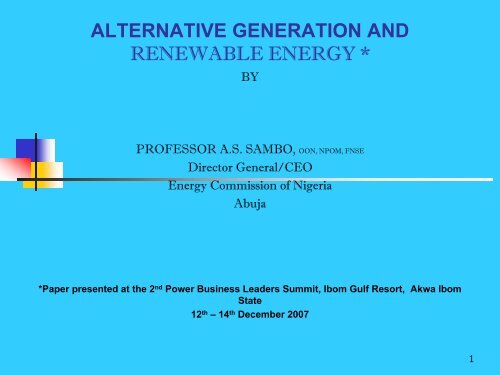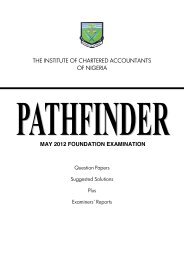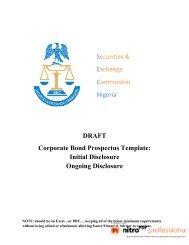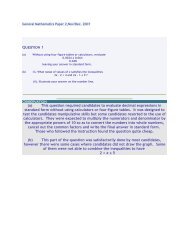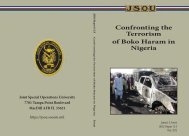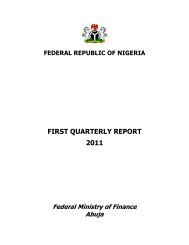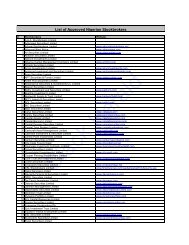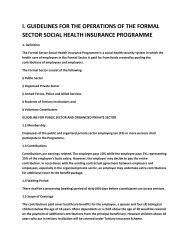View - Energy commission of Nigeria
View - Energy commission of Nigeria
View - Energy commission of Nigeria
You also want an ePaper? Increase the reach of your titles
YUMPU automatically turns print PDFs into web optimized ePapers that Google loves.
Introduction ………. Cont’d• Despite the abundance <strong>of</strong> energy resources in <strong>Nigeria</strong>,electricity generation is mainly from large hydro, naturalgas, LPFO and diesel; and the supply is far short <strong>of</strong>demand.• Only about 40% <strong>of</strong> the nation’s about 140 million peoplehas access to grid electricity.• At the rural level, where about 70% <strong>of</strong> the population live,the availability <strong>of</strong> electricity drops to about 18%.• The objective <strong>of</strong> this presentation is to highlight how thenation’s renewable energy resources could be utilized toincrease electricity access for sustainable nationaldevelopment.Pr<strong>of</strong>. A. S. Sambo8
2. DEVELOPMENT OF THE NATIONALENERGY POLICY (NEP)• In 1990 the ECN appointed a committee comprising somemembers <strong>of</strong> the Commission’s Technical AdvisoryCommittee, Directors <strong>of</strong> the <strong>Energy</strong> Research Centresalong with some energy experts and chaired by the DG todraft the NEP,• A draft NEP was submitted to Government in 1993,• Reviewed by an Inter-ministerial Committee in 1996, atthe instance <strong>of</strong> the Head <strong>of</strong> State, under the Chairmanship<strong>of</strong> the Ministry <strong>of</strong> Science and Technology,• Again reviewed in 2002 in response to the 1999Privatization Act which, restructured the entire economytowards greater private sector participation and, indeed,private sector leadership;Pr<strong>of</strong>. A. S. Sambo9
2. Development <strong>of</strong> the National <strong>Energy</strong>Policy (NEP)• The review was by an Inter-ministerial Committee withmembership from the major energy sub-sectors, pr<strong>of</strong>essionaland financial institutions;• The reviewed policy document was approved by the FederalGovernment in April, 2003 and was launched by Mr.President, on 20 th June 2005.• The NEP articulates for the sustainable exploitation andutilization <strong>of</strong> all viable energy resources in the country• The policy is, thus, hinged on private sector development <strong>of</strong>the energy sector.Pr<strong>of</strong>. A. S. Sambo10
3. The Policy Framework on Renewable<strong>Energy</strong> in <strong>Nigeria</strong>The renewable component <strong>of</strong> the NEP articulates as follows:• Hydropower: The NEP provides that:- The nation shall fully harness the hydropowerpotential for electricity generation- The nation shall pay particular attention to thedevelopment <strong>of</strong> the mini and micro hydropowerschemes- The exploitation <strong>of</strong> the hydropower resources shallbe done in an environmentally sustainable manner- Private sector and indigenous participation inhydropower development shall be actively promoted.Pr<strong>of</strong>. A. S. Sambo11
2. The Policy Framework on Renewable …… Cont’dPr<strong>of</strong>. A. S. Sambo• Fuelwood: The NEP provides that:- The nation shall promote the use <strong>of</strong> alternativeenergy sources to fuelwood- The nation shall promote improved efficiency in theuse <strong>of</strong> fuelwood- The use <strong>of</strong> wood as a fuel shall be de-emphasized inthe nation’s energy mix- The nation shall intensify efforts to increase thepercentage <strong>of</strong> land mass covered by forests in thecountry.• Solar <strong>Energy</strong>: The policy provides that:- The nation shall aggressively pursue the integration<strong>of</strong> solar energy into the nation’s energy mix.- The nation shall keep abreast <strong>of</strong> worldwidedevelopment in solar energy technology.12
2. The Policy Framework on Renewable …… Cont’d• Biomass: The NEP provides that:- The nation shall effectively harness non-fuelwood biomassenergy resources and integrate them with other energy resources- The nation shall promote the use <strong>of</strong> efficient biomassconversion technology• Wind: The Policy provides that:- The nation shall commercially develop its wind energy resourceand integrate this with other energy resources into a balancedenergy mix- The nation shall take necessary measures to ensure that this form<strong>of</strong> energy is harnessed at sustainable costs to both suppliersand consumers in the rural areas.• Hydrogen: The policy provides that:- The nation shall integrate hydrogen as an energy source in theenergy mix <strong>of</strong> the country• Other Renewables: The policy provides that:- The nation shall maintain an interest in other emerging sources<strong>of</strong> renewable energy such as geothermal and ocean related energy.Pr<strong>of</strong>. A. S. Sambo13
4. NATIONAL ENERGY MASTERPLAN NEMP)AND THE RENWEABLE ENERGY MASTERPLAN (REMP)• In order to have a planned and coordinated implementation<strong>of</strong> the National energy Policy, a roadmap is imperative.• To this effect, the FGN constituted a National <strong>Energy</strong>Masterplan Committee, which was inaugurated in 2006 withthe mandate to draw up a comprehensive roadmap for theplanned implementation <strong>of</strong> NEP.• The draft NEMP is now before the Federal Government forconsideration and approval.• In 2005, the <strong>Energy</strong> Commission in collaboration with theUNDP and other stakeholders formed a Committee thatdrafted a renewable energy masterplan, a component <strong>of</strong> theNEMP, which has been integrated into the draft NEMP nowbefore the Government.Pr<strong>of</strong>. A. S. Sambo14
4. National <strong>Energy</strong> Masterplan (NEMP) and the Reneweable<strong>Energy</strong> Master Plan (REMP) …………. . Cont’d• The REMP is a roadmap for the planned implementation <strong>of</strong> the renewableenergy component <strong>of</strong> the NEP with timelines, targets and milestones.• It is basically structured into the following programmes with short,medium and long term targets :- National Biomass <strong>Energy</strong> Programme- National Solar <strong>Energy</strong> Programme- National Hdropower Programme- National Wind <strong>Energy</strong> Programme- Emerging <strong>Energy</strong> Programme- Framewoark Programme for Renewable <strong>Energy</strong> Promotion• The Framework programme articulates issues that are common to all othersub-sectoral programmes, i.e.- Legal, Regulatory and Institutional framework- Incentives- Capacity Building (Human and Infrastructural)- Public Awareness- Inter-Agency/Governmental Collaboration- Research and Development- Monitoring and Evaluation15Pr<strong>of</strong>. A. S. Sambo
4. National <strong>Energy</strong> Masterplan (NEMP) and the Reneweable<strong>Energy</strong> Master Plan (REMP) …………. . Cont’dReneweable Electricity Targets:• A Study conducted by the Presidential Committee on a 25-year power development plan, constituted in 2005, came upwith a projected electricity demand pr<strong>of</strong>ile for the nation <strong>of</strong>about 15,000 MW; 30,000 MW; and 190,000 MW in theshort, medium and long terms on the basis <strong>of</strong> a 10%economic growth rate scenario.• With these projections, a study by the <strong>Energy</strong> Commission<strong>of</strong> <strong>Nigeria</strong> indicated that renewable electricity is expected tocontribute about 14%; 23%; and 36% <strong>of</strong> the total electricitydemand in the short, medium and long terms, respectivelyas dictated by the National <strong>Energy</strong> Policy.Pr<strong>of</strong>. A. S. Sambo16
4. National <strong>Energy</strong> Masterplan (NEMP) and the Reneweable<strong>Energy</strong> Master Plan (REMP) …………. . Cont’dS/N. RESOURCE SHORT MEDIUM LONG1 Hydro (large) 1930 5930 48,0002 Hydro (small) 100 734 19,0003 Solar PV 5 120 5004 Solar Thermal - 1 55 Biomass - 100 8006 Wind 1 20 40All Renewables 2,036 6,905 68,345All <strong>Energy</strong> Resources15,000 30,000 190,000% <strong>of</strong> Renewables 14% 23% 36%Pr<strong>of</strong>. A. S. Sambo17
5. Renewable Electricity Technologies• Bioelectricity:- This is electricity generated from biodegradable biomass e.g.residues and wastes from agriculture, forestry and relatedindustries, municipal and industrial wastes as well as energy cropsand plantations.- The conventional technologies <strong>of</strong> power production, through theRankine/Otto/Diesel cycles, are <strong>of</strong>ten employed. The energysupplied at the boiler is sourced from the biodegradableenergy carrier, through either:a) Direct combustionb) Gasification, e.g. anaerobic digestion.c) Biomass-to-Liquids (BTL) e.g. bi<strong>of</strong>uels- Ordinary bioelectricity plants have efficiencies <strong>of</strong> about 20%,while the combined heat and power plants (CHP) may havehigher efficiencies.- Bioelectricity may be accompanied with environmentalproblems <strong>of</strong> greenhouse gas emissions, <strong>of</strong> varying magnitudes,depending upon the emission control technology adopted.Pr<strong>of</strong>. A. S. Sambo18
5. Renewable Electricity Technologies…..Cont’dA Typical 750 kW Bio-electricity PlantPr<strong>of</strong>. A. S. Sambo19
5. Renewable Electricity Technologies …. Cont’d• Solar Electricity- Electricity from solar energy may be obtained through (i) Solarthermal process and (ii) Solar Photovoltaic (PV)- Electricity from solar thermal processes is similar to that inbioelectricity using the Rankine cycle.- Solar photovoltaics refers to the direct and silent conversion <strong>of</strong> solarenergy into electricity, usually DC form, using a solar cell.- Solar cells may be made from (i) Polycrystalline silicon (ii) singlesilicon (iii) amorphous silicon or (iv) thin film silicon- A solar cell can have an output <strong>of</strong> about 0.5V, 3.5 amp dc andefficiency <strong>of</strong> up to 16%.- A solar module or panel consist <strong>of</strong> many solar cells, suitablyarranged, to give an output <strong>of</strong> greater than 12V and 3.5-7 ampsat 1kW/m² solar intensity.Pr<strong>of</strong>. A. S. Sambo20
5. Renewable Electricity Technologies ….. Cont’d- Modules can last up to 25 years.- A solar array consists <strong>of</strong> many modules connectedtogether.- Thus a solar PV generator is made up <strong>of</strong>:- Solar cells- Solar modules- Solar arraysPr<strong>of</strong>. A. S. Sambo21
5. Renewable Electricity Technologies ….. Cont’d- The complete components <strong>of</strong>a solar PV systems include:- Solar PV generator- Deep cycle, heavy dutylead-acid or Gel-cell leadacid, batteries,- Controllers for theregulation <strong>of</strong> chargingand discharging <strong>of</strong>the batteries- Inverters for theconversion <strong>of</strong> dc to ac- Other balance-<strong>of</strong>-systemcomponents are:mounting hardware,switches, cables, circuitbreakers, connectors andlighting arrestor.Pr<strong>of</strong>. A. S. SamboFig. 3: PV Characteristics:IntensityEffect <strong>of</strong> Solar22
6. Renewable Electricity Production ……Cont’d5MWp Solar PV Plant in Leipzig, GermanyPr<strong>of</strong>. A. S. Sambo23
5.. Renewable Electricity Technologies ….. Cont’d• Wind Electricity- Wind energy exists as a form <strong>of</strong> kinetic energy.- Electricity from wind energy is produced using anaerogenerator, which is an electro-mechanicalsystem.- Aerogenerators could be mounted on towers up to100m.- The tower may be self-supporting or guyed.Pr<strong>of</strong>. A. S. Sambo24
5. Renewable Electricity Technologies ….. Cont’dFig. 4: Main Components <strong>of</strong> a Wind Electricity GeneratorPr<strong>of</strong>. A. S. Sambo25
5. Renewable Electricity Technologies ….. Cont’d- The mechanical power output <strong>of</strong> a wind machinemay be expressed as:- Pout = Cp (½ SAV³)- Where Cp is Beltz limit (≅ 0.59)A is Rotor swept AreaS is density <strong>of</strong> airV is wind speed- Maximum theoretical efficiency <strong>of</strong> wind machine isabout 59% (Beltz limit). Typical practicalaerogenerator efficiencies lie between 10% and30%.- Aerogenerators may produce ac or dc current,depending upon the types <strong>of</strong> generators.Pr<strong>of</strong>. A. S. Sambo26
5. Renewable Electricity Technologies ….. Cont’dFig. 5: A Typical Power Output Curve <strong>of</strong> aWind Powered Turbine (Ge Power System –1.5 SL)- Wind electricity is <strong>of</strong>tengenerated onshore for singleunit capacities <strong>of</strong> up to 5MW.- Wind electricity can also begenerated from both the shallowand deep <strong>of</strong>fshore waters forsingle unit capacities greaterthan 5MW, because <strong>of</strong> higherwind.- Wind turbines have life spans <strong>of</strong>20 – 25 years.Pr<strong>of</strong>. A. S. Sambo27
5. Renewable Electricity Technologies ….. Cont’dWind ElectricityProductionPr<strong>of</strong>. A. S. Sambo28
5. Renewable Electricity Technologies ….. Cont’d• Hydroelectricity- Hydroelectricity comes from the conversion <strong>of</strong> potentialenergy water into electricity by water turbines and electricgenerator system.- Large hydro systems have the disadvantage <strong>of</strong> displacement<strong>of</strong> people, land and ecosystem submersion, dam inducedearth movements, and GHG emission.- Large hydro systems are those rated greater than 30MWwhile small hydro systems are less than or equal to 30MW.- Small hydro is further classified into: Pico: < 5kW Micro: 5kW-100kW Mini: 100kW-1MW Small: 1MW-30MW•Pr<strong>of</strong>. A. S. Sambo29
5. Renewable Electricity Technologies ….. Cont’d• Hydrogen Fuel CellElectricity- In fuel cell, the chemical energy<strong>of</strong> the fuel is converted directlyto electrical energy.- The most advanced fuel cell isthe hydrogen – oxygen fuel cell.The system consists <strong>of</strong> porouselectrodes, an electrolyte,hydrogen as the fuel andoxygen as the oxidant. Theoutput from the system iselectricity and water.Fig. 6: Schematic representation <strong>of</strong> a hydrogen –oxygen fuel cellPr<strong>of</strong>. A. S. Sambo30
5. Renewable Electricity Technologies ….. Cont’d- The reactions are as follows:H 2+ 2OH = 2H 2O + 2e¯2e¯+ ½ O 2+ H 2O = 2OH¯H2 + ½ O 2=H 2O- Fuel cell can haveefficiency <strong>of</strong> up to 83%.Fig. 7: Steady-flow process <strong>of</strong> a fuelcellPr<strong>of</strong>. A. S. Sambo31
5. Renewable Electricity Technologies….. Cont’dCost Comparison <strong>of</strong> Renewable Electricity TechnologiesTable 2: Cost Estimates <strong>of</strong> RE ElectricitySystemsTechnologyInvestment Cost[$/kW]High-SideGenerationCosts[Cents/kWhLife-Span [Yrs]Large Hydro1,000 – 2,0005 – 1020 - 30Small Hydro1,000 – 5,0009 – 1520 - 30Solar PV4,500 – 7,00025 – 8020 - 30Solar ThermalElectricity(Concentrating)3,000 – 6,00020 – 2515 - 25Bioelectricity500 – 4,00010 – 1515 - 25Wind Electricity850 – 1,70010 - 1220- 25Pr<strong>of</strong>. A. S. Sambo32
6. RENEWABLE ELECTRICITYPRODUCTION NIGERIA:• Out <strong>of</strong> the five renewable electricity technologieshighlighted in section 4, only the following are beingemployed in <strong>Nigeria</strong>:- Hydroelectricity,- Solar Photovoltaics,- Wind electricity.Pr<strong>of</strong>. A. S. Sambo33
6. Renewable Electricity Production ……Cont’d• Hydroelectricity• This Table shows thathydroelectricity contributedabout 38.5% <strong>of</strong> the total gridelectricity production in <strong>Nigeria</strong>between 1999 and 2004. Thiscontribution is mainly from thethree large hydropower stations inKainji (760MW), Jebba (578MW)and Shiroro (600MW) owned byGovernment, as well as the smallhydropower stations owned byNESCO in Jos <strong>of</strong> 30MWcapacity.Year Grid Electricity Produced (TWh)Thermal Hydro Total1999 8.673 7.619 16.2922000 8.443 6.784 15.2272001 8.610 6.194 14.8042002 13.208 6.390 19.5992003 13.258 7.753 21.0112004 16.122 8.087 24.209Source: NBS (2005)Pr<strong>of</strong>. A. S. Sambo34
6. Renewable Electricity Production ……Cont’dPr<strong>of</strong>. A. S. SamboExisting Generation Capacity 2007Plant Age (Year InstalledUnits (No)InstalledCapacity (MW)UnitsAvaible (No)CapacityAvailable(MW)OperationalCapability(MW)Thermal:Egbin 22 6 1320 4 880 600Egbin AES 6 9 270 9 270 220Sapele 25-29 10 1020 1 90 65Okpai 2 3 480 2 480 240Afam 25 20 702 3 300 130Delta 17 18 840 12 540 330Omoku 2 6 150 4 100 70Ajaokuta n.a. 2 110 2 100 80Geregu 1 3 414 3 41 414Omotosho New 8 335 2 80 0Olorunsogo/Paplanto New 8 335 2 80 0Sub-total 93 5976 44 3334 2149Hydro:Kainji 38-40 8 760 6 440 400Jebba 24 6 540 6 540 300Shiroro 22 4 600 2 600 300Sub-total 18 1900 14 1580 1000Grand-total 111 7876 58 4914 3149Source: PHCN• Installed Capacity: Hydro ≈ 24%• Availability: Hydro ≈ 32%35
6. Renewable Electricity Production ……Cont’dPr<strong>of</strong>. A. S. Sambo36
6. Renewable Electricity Production ……Cont’d• Solar Electricity- As at 1999 about 239 kWp <strong>of</strong> Solar PV modulesere installed nationwide. It is useful to note that:- This is equivalent to about 1.88 TWh/annum <strong>of</strong> relectrical energy using 6 hours <strong>of</strong> sunshine daily.- It comes to about 25% <strong>of</strong> the hydroelectric energyproduced that year.- The installations consisted <strong>of</strong> 52% for waterpumping, 24% for lighting, 15% for lighting in<strong>of</strong>fices and 9% for powering health clinics.- The current estimate <strong>of</strong> the total solar PVinstallations is put at 1MW.Pr<strong>of</strong>. A. S. Sambo37
6. Renewable Electricity Production……Cont’dPr<strong>of</strong>. A. S. Sambo38
6. Renewable Electricity Production ……Cont’dPr<strong>of</strong>. A. S. Sambo39
6. Renewable Electricity Production ……Cont’d(c) : 2.85 kWp Solar PV Plant at Itu-Mbauzo, Abia StatePr<strong>of</strong>. A. S. Sambo40
6. Renewable Electricity Production ……Cont’d• Wind Electricity- Wind electricity has not beensignificantly harnessed in thecountry despite the greatpotentials.- The only functional windelectricity system in thecountry is the 5kWaerogenerator, which supplieselectricity to Sayya Gidan GadaVillage in Sokoto State..Fig. 9: 5kW aero generator in Sayya Gidan Gada,Sokoto StatePr<strong>of</strong>. A. S. Sambo41
7. CHALLENGES TOWARDS RENEWABLEELECTRICITY DEVELOPMENT IN NIGERIA• Capacity Limitation:- The technical expertise to develop, deploy and managerenewable energy is inadequate, and worst still, notrelied upon in the country as expertise is <strong>of</strong>ten sourcedfrom outside the country.- The infrastructure for the manufacture <strong>of</strong> renewableelectricity system components is not available in thecountry. Supply <strong>of</strong> systems and components is, thus,dependent on imports.• Financial and Fiscal Incentives:- Financial and fiscal incentives are not available to fasttrackthe development <strong>of</strong> the supply and demand sides <strong>of</strong>the RE electricity market.Pr<strong>of</strong>. A. S. Sambo42
7. Challenges Towards Renewable …… Cont’d• Lack <strong>of</strong> Awareness:- There is the general lack <strong>of</strong> awareness <strong>of</strong> the benefits <strong>of</strong> RE electricity.• Inadequate Resource Assessment:- Reliable resource database to assist investment decisions for REelectricity industry is absent.• Inadequate Institutional Framework:- With the mandate <strong>of</strong> the NERC limited to electricity plant capacities<strong>of</strong> 1MW and above, there is no agency to licence smaller capacities thatare <strong>of</strong>ten associated with RE electricity.• Intermittency <strong>of</strong> Resource Availability- All renewable resources for electricity generation are availableintermittently and cyclic. The challenge <strong>of</strong> energy storage and systemmanagement during periods <strong>of</strong> lack <strong>of</strong> resource add to the complexity<strong>of</strong> the systems.Pr<strong>of</strong>. A. S. Sambo43
7. Challenges Towards Renewable …… Cont’d• Zero Resource Cost:- Apart from bioelectricity, resource for RE electricity is free. Eventhough this is an advantage for reducing the operating cost <strong>of</strong> REelectricity systems, the challenge is to make RE electricity systemsoverwhelmingly competitive.• High Initial Investment Cost:- RE electricity systems have high initial cost. This has limited thepenetration <strong>of</strong> the system into the electricity market.• Deregulated and Liberalized <strong>Energy</strong> Industry:- With the deregulation and liberalization <strong>of</strong> the energy sector in<strong>Nigeria</strong>, a conducive atmosphere is created for appropriate tariffson electricity services in the country. This opportunity wouldenable RE electricity to be competitive in the market, in themedium to long term.• Adequate Policy Framework on RE:- Having approved the National <strong>Energy</strong> Policy a major challenge isto get the National <strong>Energy</strong> Masterp;an to also be approved andPr<strong>of</strong>. A. S. Samboimplemented.44
8. THE WAY FORWARD• Approval <strong>of</strong> the National <strong>Energy</strong> Masterplan• Institutionalization <strong>of</strong> the National <strong>Energy</strong> Policy and theNational <strong>Energy</strong> Masterplan through an Act <strong>of</strong> theNational Assembly for sustainability.• Establishment <strong>of</strong> a Renewable <strong>Energy</strong> Fund to serve as theinstrument for the provision <strong>of</strong> financial incentives to localmanufacturers, suppliers and users <strong>of</strong> RE electricity,especially with reference to the rural areas.• Provision <strong>of</strong> adequate fiscal incentives to local suppliersand manufacturers <strong>of</strong> RE electricity system components.• Sustenance <strong>of</strong> the energy sector reforms by successivegovernments.Pr<strong>of</strong>. A. S. Sambo45
8. The Way Forward ………. Cont’d• Intensification <strong>of</strong> promotional and advocacy activities on REelectricity by the <strong>Energy</strong> Commission <strong>of</strong> <strong>Nigeria</strong> and allstakeholders.• Intensification <strong>of</strong> R and D into RE electricity technology t<strong>of</strong>urther bring down costs.• The enormous financial benefits now derived from thedepletable fossil resources need to be partly invested in thedevelopment <strong>of</strong> RE electricity infrastructure in partnershipwith the private sector.• Establishment <strong>of</strong> regulatory framework for the RE electricityindustry.• Development and sustenance <strong>of</strong> the RE resource database.• Scaling-up <strong>of</strong> RE pilot projects to large commercial systemsPr<strong>of</strong>. A. S. Sambo46
9. CONCLUSIONS• <strong>Nigeria</strong> has abundant renewable energy resources in the country.• The low level <strong>of</strong> electricity access in <strong>Nigeria</strong>, and particularly in therural areas, can be increased through the use <strong>of</strong> these renewable energyresources for sustainable development.• Hydro, solar, wind and biomass have significant potentials to make thedifference.• Renewable electricity is projected to contribute 14%, 23% and 36% inmeeting the nation’s total electricity demand in the short, medium andlong terms.• There is the need to institutionalize both the NEP and the NEMP(incorporating the REMP) through an Act <strong>of</strong> the National Assemblyfor sustainability.• There is the need the establishment <strong>of</strong> a RE Fund to cater forincentives to local manufacturers, suppliers and users <strong>of</strong> RE electricity.• There is the need for fiscal incentives to local suppliers andmanufacturers <strong>of</strong> RE electricity system components in the country.• Scaling-up <strong>of</strong> RE pilots to commercial systems is necessary formeaningful impact in the economy.Pr<strong>of</strong>. A. S. Sambo47
Pr<strong>of</strong>. A. S. Sambo48


